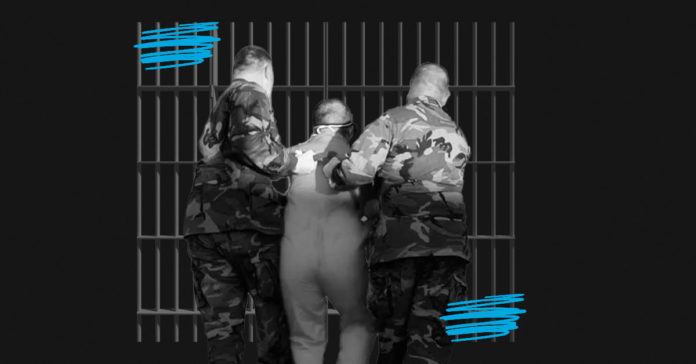In the medieval period considerable numbers of Muslims fell under Christian captivity. Their fate was universally horrific: their mass slaughter was a rule. In 1191, for instance, Acre was retaken by the crusaders and Richard of England, devious and greedy,[1] had thousands of Muslim prisoners beheaded before the walls as a hint to Salah Eddin to hurry to pay the ransom of prisoners. [2] Richard had not just the garrison massacred, but also women and children.[3]
At the very decisive battle of Navas de Tolosa, in 1212, Al-Nasir’s much superior Muslim army was crushed, and in the wake of the battle, 70,000 Muslim prisoners were slaughtered at the order of the Bishops of Toledo and Narbonne who were at the scene.[4] In contrast, not long before, on 18th July, 1196, Abu Yusuf Yaqub al-Mansur inflicted a crushing defeat on Alfonso VIII of Castile at Alarcos, the Christian army being virtually exterminated.[5] After the victory, Abu Yaqub freed twenty thousand Christian prisoners without even demanding a ransom.[6] In the rare instances when Muslims were not slaughtered, their fate was dreadful. The late 12th century Muslim traveller, Ibn Jubayr, who went to crusader-held territory, devotes some of his most emotional lines to a description of the captive Muslim men stumbling in shackles and doing hard labour like slaves, and the captive Muslim women plodding along with iron rings on their legs.[7] Muslims had been enslaved during the crusader conquest and many were captured and enslaved again during subsequent rounds of Frankish-Muslim warfare.[8] Any Muslim seeking to escape their fate by running away risked losing their legs when caught.[9]
Subsequently, in the so-called Barbary Corsair era (17th-181h centuries) the treatment of Muslim captives remained equally dreadful. The French mathematician, Bachet, in his textbook: Problems, published in Lvons in 1624, uses the following example as one of his problems:
‘A ship carrying as passengers fifteen Turks and fifteen Christians, encountered a storm. The pilot declared that, in order to save the ship and crew, one half of the passengers must be thrown into the sea. To choose the victims the passengers were arranged in a circle and it was agreed that every ninth man should be cast overboard, reckoning from a certain point. It is desired to find an arrangement by which all the Christians should be saved!’[10]
Of course, anecdote mirrors reality. In their galleys, the French tried West African Blacks and Iroqois Indians, both unsuccessfully; and the elites of such galleys remained the Muslims of North Africa.[11] Turkish or North African slaves were always preferred for galleys, particularly those of France, because they were a tougher breed than convicts.[12] Experts considered the Turks, and especially the North Africans, to have no equal as rowers, and it was felt essential to have at least one Muslim slave per bench.[13] In the 18th century the galleys of France declined in importance until the Corps des Galeres (The Corps of Galleys) was abolished in 1748, but as Bamford said:
‘The Infidel Turk, with his distinctive clothing, moustache and reputation for physical strength, was a symbol of the old fighting galley.’[14]
As late as 1712 there were over 1000 Turks in the galleys. Spanish, Neapolitan and Papal galleys were also a destination for Muslim slaves sold in Malta.[15] The life of a galley slave has been described by a Frenchman who had experienced it:
‘Picture to yourself six men chained to a bench, naked as they were born, one foot on the stretcher, the other lifted and placed against the bench in front of him, supporting in their hands a heavy oar and stretching their bodies backward while their arms were extended to push the loom of the oar clear of the backs of those in front of them… sometimes the galley slaves row ten, twelve and even twenty hours at a stretch, without the slightest rest or break. On these occasions the officer will go round and put pieces of bread soaked in wine into the mouths of the wretched rowers to prevent them from fainting. Then the captain will call upon the officers to redouble their blows, and if a slave falls exhausted over his oar (which is quite a comma occurrence) he is flogged until he appears to be dead and is thrown overboard without ceremony.’[16]
Christians who had converted to Islam, when caught, were handed over to the Inquisition.[17]
Those who have experienced Muslim and Christian captivity on land witnessed to the harshness of the latter. As Lloyd points out, compared with the hard life of a seaman on board a merchant vessel, not to say the navy which was worse, a common seaman cannot have found life in bagnio (Muslim prison) much harder, certainly as many have left on record, it was preferable to life in a European gaol.[18] Edward Coxere, who was freed after Blake bombarded the port of Tunis, became a Quaker and, as soon as he returned home, was imprisoned under the Conventicle Act. This is how he compared his captivity in Yarmouth prison with that of Tunis:
‘They allowed us water enough to drink, but nothing to eat, nor bread to be brought us, nor nobody to come near us… Such unkind usage I never had when I was a slave under the hands of the Turks, such as Christians call Infidels, that though I was chained a nights with great iron chain, and was made to work a days, and sometimes beat, yet they gave me bellyful of bread to eat with my water; but here, among my countrymen and such as called Christians, they gave me not the privilege as they gave their dogs, for they would deny anyone to give them a crust of bread.’[19]
And whilst the fate of Christians in Muslim captivity (as the following heading amply shows) was hopeful, the case of Muslims in Christian captivity was hopeless. Earle speaks about a Muslim slave from Damietta who petitioned for his freedom in 1682. He said that he had been a slave for fifty four years, fifty of which he had spent as an oarsman in the galleys.[20] On two occasions he had been promised his liberty for special services. The first was at the battle of the Dardanelles in 1656. Twenty years later he was again promised his liberty for his services in burying infected slaves during the plague of 1676. Neither of these promises had been honoured, however, and ‘now the poor supplicant is over eighty years old and desires to finish his life in his own country’, for which reason he begged that ‘he could be placed in the number of old slaves who are being sent to liberty as a result of alms sent from Barbary.’[21]
There is an interesting account of the end of the Muslim captives in Malta:
‘In 1749, an alleged slave plot led to a trial ‘when nearly all the slaves were condemned to death. They were tortured and executed in batches. Most of the ‘Infidels’ were marched through the streets of Valetta and led to high scaffolds erected in the public squares on which they were birched, branded and finally hanged, beheaded or quartered. Those who consented to be baptised were put to death without further torture. These cruel scenes went on for a whole month, the (Christian) knights showing themselves pitiless avengers.’[22]
The Muslims who fell into the captivity of the Inquisition is too horrific, too traumatic to go into here beyond this short extract. The Inquisition was a medieval Catholic invention. Its purpose was to remove ‘heretics’ from the midst of Christians. In Spain, its main victims were the Muslims and Jews. Generally, they ended up tortured in dungeons, confessing whatever their accusers sought to make them confess, burnt at the stake, or disappeared for ever, their properties confiscated, their families thrown into perpetual want. The best work on the subject of Christian persecution of Muslims through the Inquisition is by Henry Charles Lea who studied contemporary accounts and sources.[23] The following extracts from his work are by Thomson and Rahim:
‘The Inquisitors felt it their duty to investigate their (the Muslims’ and Jews’) minds, and to eliminate anyone whose words or deeds confirmed their suspicion. Their methods were even more callous and efficient than the ones which had been employed by the medieval Inquisition in France. According to Mariana: ‘What caused the most surprise was that children paid for the crimes of their parents, and that accusers were not named or made known, nor contronted by the accused, nor was there publication of witnesses: all of which was contrary to the practice used of old in other tribunals…. And what was most serious was that because of these secret investigations, they were deprived of the liberty to hear and talk freely, since in all cities, towns and villages there were persons placed to give information of what went on. This was considered by some the most wretched slavery and equal to death.[24]
Then, death in Christian hands meant, in general, burning alive. Countless numbers of Muslims, tens of thousands, possibly, were burnt alive at the stake. Even in their death, the Muslims had crowds standing armed with stones ready to throw at them as soon as the Muslims started reciting their shahadas.[25]
The condition of Muslim captives in Western hands in recent times is a continuity of terrible sufferings and, generally, tragic ends, in every place and at all times. The killings of Muslim prisoners during the colonial period, whether in India, or in Egypt, and parts of Africa would fill volumes, just like the traumatic experiences they went through by torture, and other forms of humiliations.[26] The recent French history in Algeria (1954-1962) is only a succession of mass torture of Algerians, executions en masse, extra-judicial killings in the tens of thousands, killings, which the French generally attributed to the ‘rebels’ fighting them (allegedly settling scores with their countrymen). Alleg et al offer an insight into instances of French torture:[27]
‘Claude Lecerf resides in a camp, where between 150 and 200 Algerians are crammed, waiting for their deaths, sleeping on straw-covered floors. Every day and every night, more operations bring in more prisoners. Above the camp is situated the interrogation centre, where torture is systematic, many leaving in a coma, many more dying under torture. The soldiers load the corpses into trucks and take them for mass burial somewhere in the countryside. At night the paratroopers force their way inside homes, which they ransack and loot,… (and bring in more prisoners). Often, ‘attempts to escape by prisoners’ are simulated; then the prisoners are shot in the back… Lecerf has seen many killings of prisoners in cold blood. One evening, one captain, P, gathers prisoners, gives them lessons on morality, and then shoots two in the head. Other officers fire in the air in direction of the rest, who run, and get cut by barbed wire… That was a recreation for the French…. All over the city (of Algiers), more prisoners are brought in to more camps. Those who have been tortured are taken out to identify more suspects. They have their heads covered in black cagoules, with two openings for their eyes. Traitors, perhaps, but surely people who because of torture have lost all control and mind. Their role is to point at others in the crowd of Algerians, who are then picked, thrown into trucks, just like dogs, and conducted to more centres for torture… On top of torture, prisoners are disappeared in their thousands, the general secretary of Algiers prefecture citing the figure of 3,000 disappeared before the end of March 1957, and the countless thousands more who were not even counted.. Interrogation centres abound, in villas, private apartments, farms, sites under construction, caves… Anyone who succumbs to torture is executed. The rule is that someone who had been tortured could not be liberated. The same is applied to intellectuals. At night more sorties are carried out in covered trucks, collecting in all centres of interrogation the countless many. Everyone is thrown on board, the half dead from torture included, all taken to large mass graves, and there the men of unit O liquidate everyone with pistols and knives… Others are taken by helicopters above the sea, and there, a large piece of concrete is tied to their feet, and they are thrown down never to resurface again. There are also many buildings being erected, and in the concrete, in the foundations of these buildings, many corpses are buried.’[28]
Today, the fate of Muslims under Western captivity is that of disappeared Muslim captives in their hundreds at least, if not thousands, people completely vanishing as if the earth had swallowed them.[29] Abu Ghreib, Guantanamo Bay, etc…. are the best-known instances of the mass torture and mass mistreatment of Muslims. In Iraq, as in many other countries, the dirty work, i.e. the arrest, followed by mass torture and mass killing, and extra-judicial killings of tens of thousands of suspects, opponents, and ‘insurgents,” is done by proxies and their death squads[30] (killings and other outrages, which then, the Western and other media, from a long and sate distance, in their cosy and comfortable world, and completely hardened to the fate of Muslims, conveniently attribute to sectarian or terrorist killings). Worse, even, Is the inhumane practice by Western powers of seizing countless numbers of Muslims who sought refuge in their lands, and delivering them to Muslim regimes whose only expertise is to inflict the worst cruelties on other humans, from boiling them alive to drilling into their flesh, to decapitations and mutilations and rape,[31] and still Westerners are delivering people to such regimes, which they protect and sponsor (as moderate/ progressive allies of the West), call themselves civilised.
[The Myth of Muslim Barbarism and its Aims by S.E. Al-Djazairi, p. 185-192]
Notes:
[1] P. W. Edbury: The Conquest of Jerusalem and the Third Crusade, (Scolar Press,
1996): p.97.
[2] F.Guizot: History of France; London; 1872; 8 Vols.439 fwd; E. Gibbon: The Decline
and Fall; op cit; VI; p. 119.
[3] M. Hodgson: The Venture, op cit; p. 267.
[4] T.B. Irving: Dates, Names and Places: The end of Islamic Spain; in Revue dHistoire Maghrebine; No 61-62; 1991; pp 77-93; at p. 81.
[5] J. Glubb: A Short History; op cit: p.190.
[6] Ibid.
[7] Ibn Jubayr: Travels; p. 322; in B. Z. Kedar: The Subjected Muslims of the Frankish Levant, in Muslims Under Latin Rule, 1100-1300, ed J.M. Powell (Princeton
University Press, 1990), pp 135-74. at p.153.
[8] In B. Z. Kedar: The Subjected Muslims; op cit; p.153.
[9] Ibid; p.170.
[10] P. Earle: Corsairs of Malta and Barbary; (Sidgwick and Jackson; London; 1970): p.8.
[11] See for instance: P. Bamford: Slaves for the galleys of France, 1665-1700, in John
Parker (ed) Merchants and Scholars; (Minneapolis; 1965): and Ibid: The Procurement of Oarsmen for the French galleys; 1660-1748; American Historical Review, LxV (1959).
[12] C. Lloyd: English Corsairs; op cit; p. 146.
[13] P. Earle: Corsairs of Malta and Barbary, op cit; p. 170.
[14] P.W. Bamford: The Procurement of Oarsmen; op cit; p. 41.
[15] P. Earle: Corsairs of Malta and Barbary, op cit; p. 170.
[16] Quot Bradfor 33.
[17] C. Lloyd: English Corsairs; op cit; p. 146.
[18] Ibid; pp. 25-6.
[19] E. Coxere: Adventures by Sea, ed . E.H. W. Meyerstein; (1945): p.100.
[20] P. Earle: Corsairs of Malta and Barbary; op cit; pp. 171-2.
[21] Archives of the Order of Malta; 646; P.215
[22] T. Zammit: History of Malta; (Valetta; 1929); p. 248.
[23] H.C. Lea: The Moriscos of Spain; (Burt Franklin; New York; 1968 reprint).
-H. C. Lea: A History of the Inquisition of Spain, 4 vols; (The Mac Millan Company,
New York. 1907).
[24] A. Thomson-M.A. Rahim: Islam in Andalus; op cit; p. 121.
[25] H.C. Lea: The Moriscos of Spain; op cit.
-H. C. Lea: A History of the Inquisition of Spain, op cit.
[26] W. Howitt: Colonisation and Christianity: (Longman; London; 1838).
H. Alleg, J. de Bonis; H.J. Douzon; J. Freire; P. Haudiquet: La Guerre d’Algerie,
(Temps Actuels; Paris; 1981).
[27] H. Alleg et al: La Guerre d’Algerie; op cit; vol 2; pp. 463 ff.
[28] Ibid; p. 469.
[29] See various reports by Human Rights agencies in 2005-6 on such disappeared
Muslims.
[30] See various sources already cited above (as in chapter one), and The Times online – January 10 2005
(http://www.timesonline.co.uk/tol/news/world/iraq/article410491.ece).
[31] The issue of rendering prisoners to these countries, and plane flights carrying
prisoners between the West and other parts, has been widely publicised in 2006; for the latest, see G. Monbiot in 1 he Guardian 8 May 07; p. 25.









